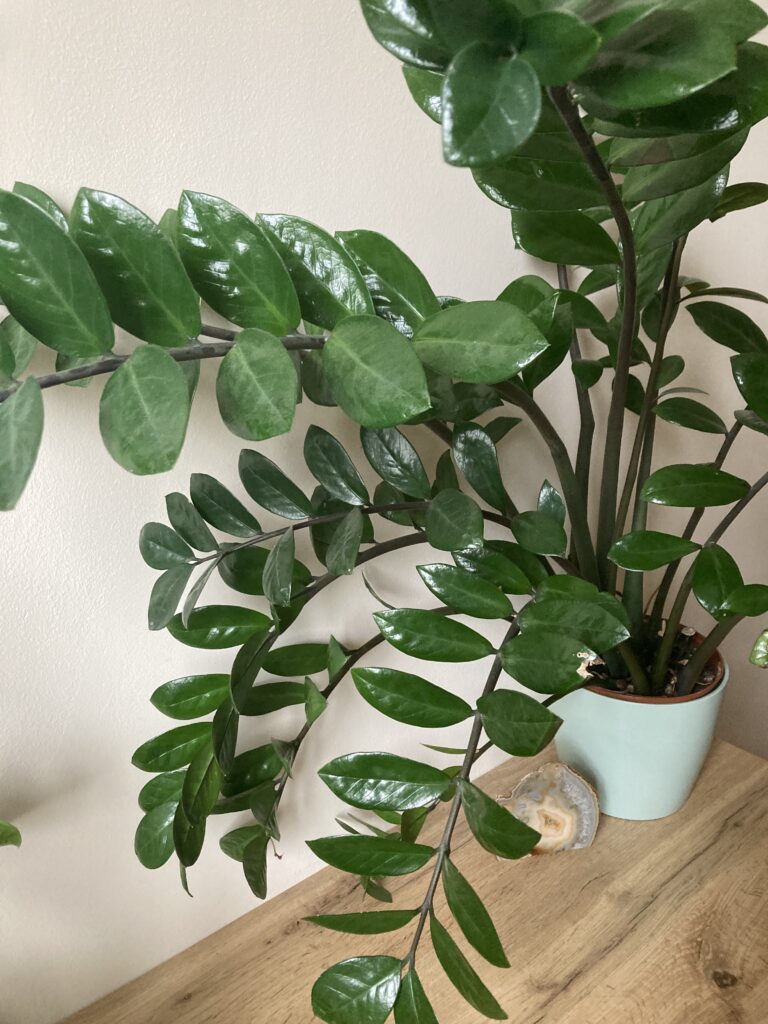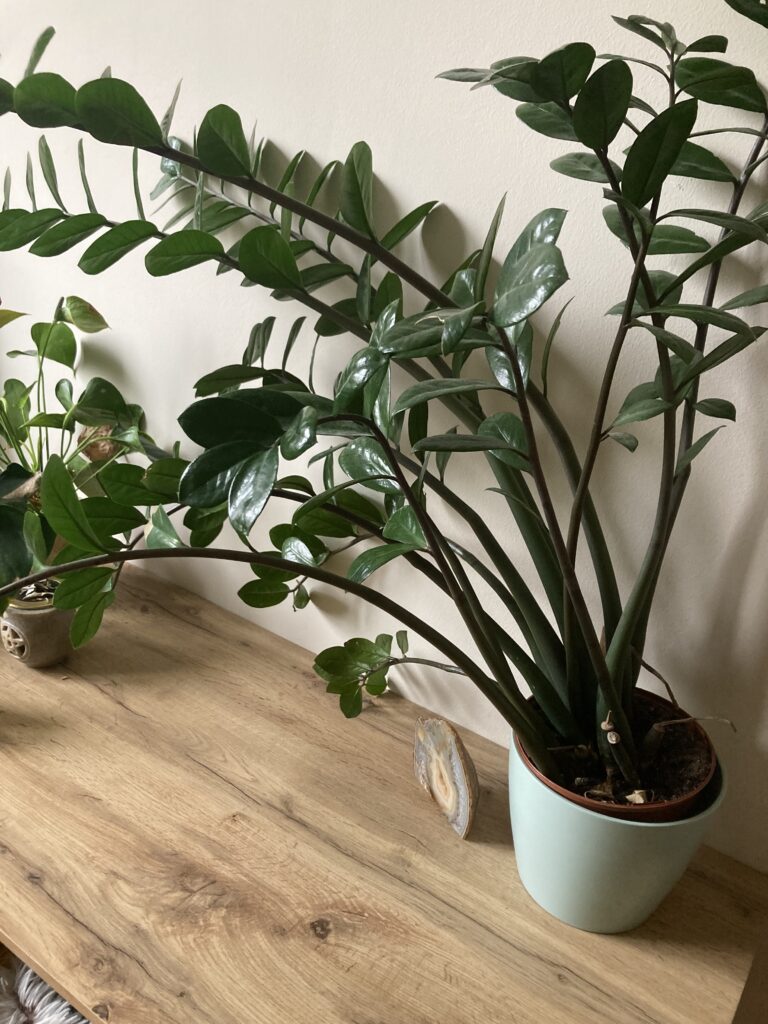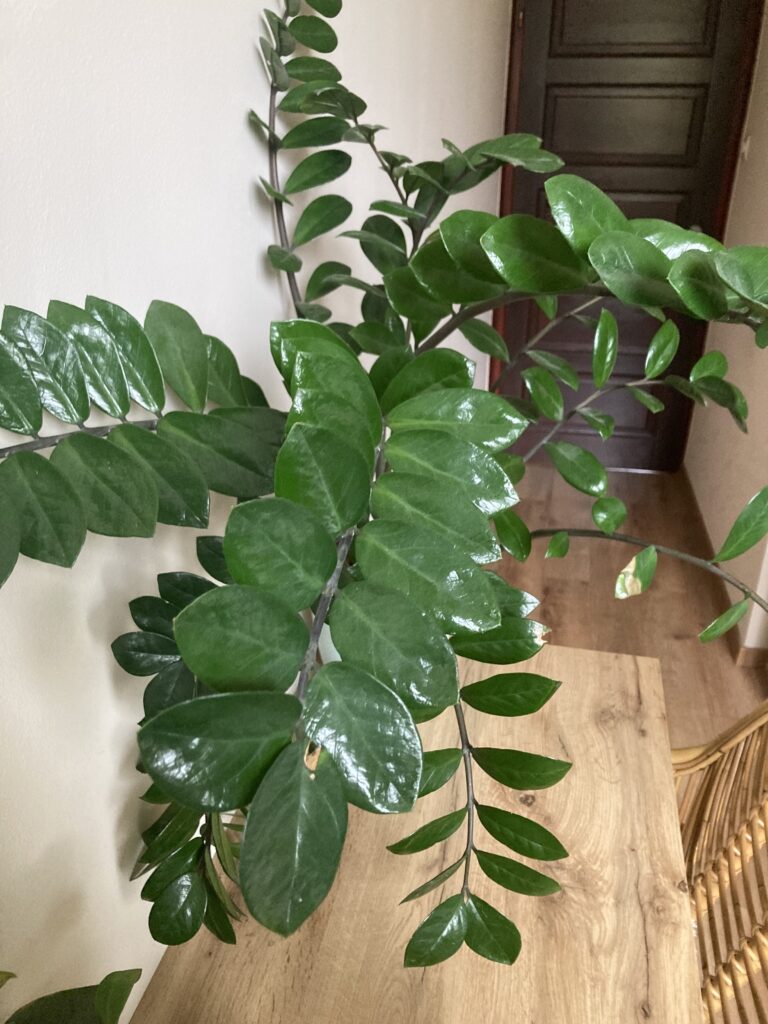The ZZ plant (latin name: Zamioculcas zamiifolia) is the only species of the Zamioculcas that is a genus of the family Araceae. It is a tropical perennial plant native to East Africa, specifically Zanzibar, Kenya, and Tanzania. The ZZ plant is also called the money tree, because it used to be said that if you put it in the corner of the room, you would be fortunate financially.
ZZ plant is a slow-growing, herbaceous evergreen plant with succulent rootstock, up to 120 cm tall. It acts as a deciduous plant when rainfall is low. This is not a common occurrence, as it can survive such periods due to the decent amount of water stored in its underground stems. The zz plant is usually used as a decorative houseplant. The ZZ plant has thick, fleshy, dark green leaves that grow in a graceful arching pattern. The leaves are shiny and waxy, with a smooth texture and a glossy appearance.
The ZZ plant is known for its toxicity. All parts of the ZZ plant are toxic and any physical contact will cause health problems for humans and pets, especially cats and dogs. Eye and skin irritation may occur if the zz plant is touched. Consumption of zz plants often causes nausea, vomiting and diarrhea.
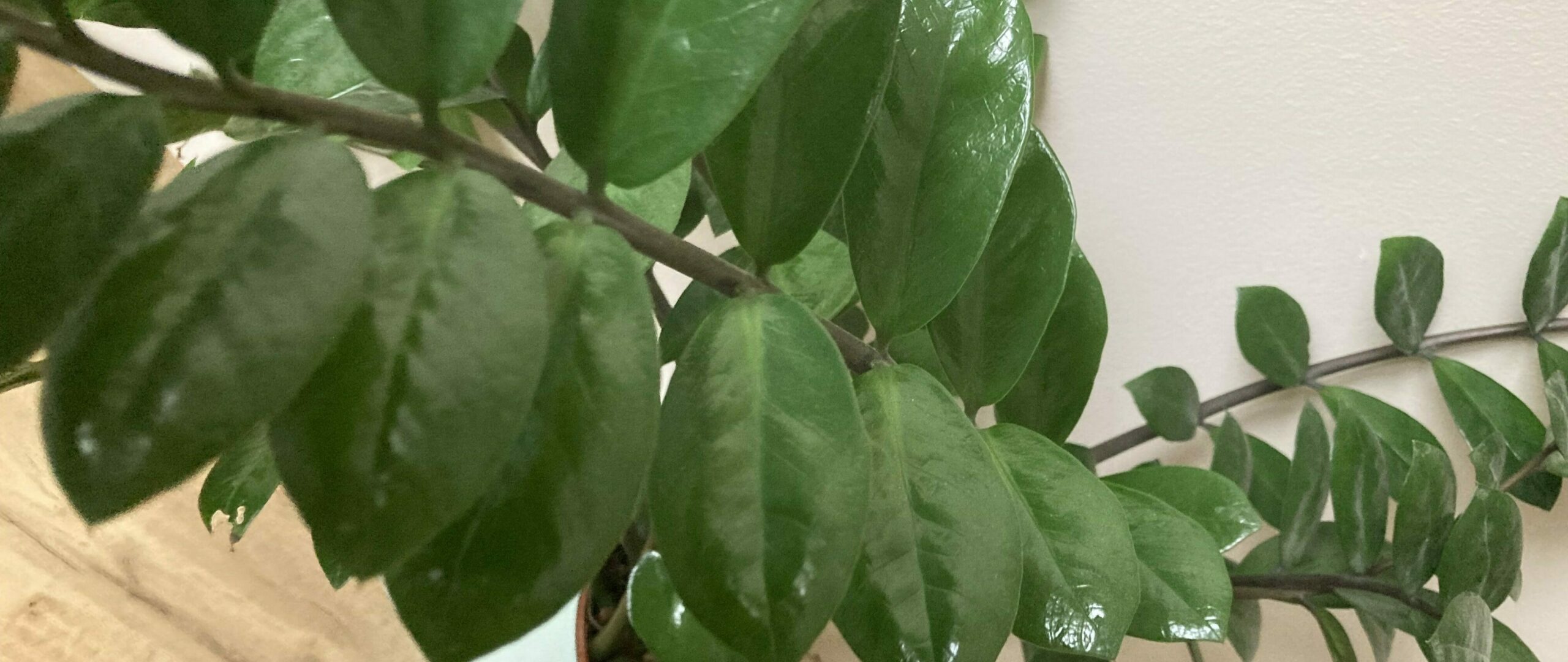
How to care for the ZZ plant?
ZZ plants do not require too much care, but there are a few things you should pay attention to. The first thing is that you always have to give the soil time to dry out between waterings. ZZ’s are fine with being watered every 2-3 weeks (or 1 a month in winter).
The second most important thing is keeping your ZZ plant away from very bright and intense direct sunlight. They feel the most comfortable in medium light, between 6 to 12 hours per day. A south-facing window is a perfect spot for it. If the leaves turn yellow and burning , immediately move it to a place out of direct light and water it a little. The leaves should be protected from the intense sunlight at all times. If the leaves are yellowing but there are no visible signs of burning, there is a risk of overwatering. In this case, try to move it to a drier environment with lower humidity.
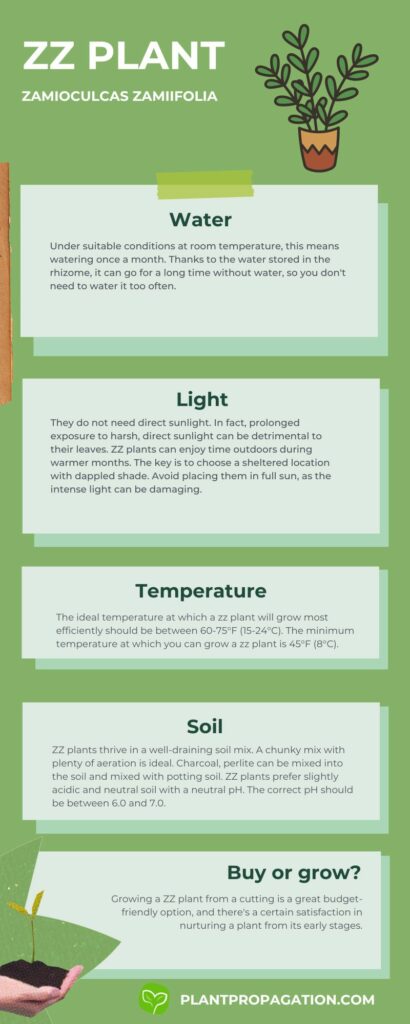
How much water does the zz plant need?
The ZZ plant is drought-tolerant and does not require much water. Thanks to the water stored in the rhizome, it can go for a long time without water, so you don’t need to water it too often. Terracotta pots dry out faster than plastic or glazed pots. If you use a terracotta pot, you might need to water slightly more often compared to other pot materials.
During warmer months with brighter light, your ZZ plant might use water a bit faster. In winter, less light and cooler temperatures may mean it needs watering less frequently. Always check the soil before watering. To avoid overwatering, the zz plant should only be watered when it is dry. Under suitable conditions at room temperature, this means watering once a month.
You need to water your zz plant when one of the following sings appear:
- The soil feels very dry and lightweight when you lift the pot.
- Leaves may start to wrinkle, curl, or feel less firm.
- The plant may look slightly droopy overall.
Water from the top until you see some excess drain from the pot’s drainage holes. Discard this excess water so the plant isn’t sitting in sogginess. Some people prefer bottom watering, which encourages root growth downwards, but it isn’t essential.
After repotting, be extra careful not to overwater immediately. Fresh soil can retain moisture for longer. Wait until the soil feels mostly dry before giving it a thorough watering.
Self watering pots can be used, but with caution. ZZ plants are extremely prone to overwatering. Choose a self-watering pot with good drainage and always be careful not to overfill the water reservoir. It’s safer to check the soil moisture manually instead of relying solely on the pot.
What kind of pot is ideal for the ZZ plant?
Choose a pot with drainage holes! This is essential for a ZZ plant. Terracotta pots are a good option as they allow the soil to dry out a bit faster compared to plastic or glazed pots. A pot that’s too large compared to the root ball of your ZZ plant will hold excess moisture longer. This increases the risk of overwatering. Choose a pot that’s only slightly bigger than the plant’s roots.
How much light does the zz plant need?
ZZ plants thrive in areas other plants might struggle with. They do not need direct sunlight. In fact, prolonged exposure to harsh, direct sunlight can be detrimental to their leaves. Their natural habitat is shaded forest floors, so they prefer bright, indirect light that mimics this dappled sunlight environment. Think of a well-lit room where you wouldn’t need artificial lights during the day. They can tolerate lower light conditions, but for optimal health, providing a good dose of indirect light is ideal.
Excessive direct sunlight can cause yellowing or browning of the ZZ plant’s leaves. You might notice faded patches or scorched areas, particularly on leaves directly hit by the sun’s rays. If left in these conditions, sun damage can continue to worsen.
While some natural fading of older leaves is normal, significant fading of color could mean your ZZ plant needs more light. This is particularly noticeable in variegated ZZ plants (those with white or yellow patterns), as these markings rely on sufficient light to stay vibrant.
ZZ plants can enjoy time outdoors during warmer months. The key is to choose a sheltered location with dappled shade. Avoid placing them in full sun, as the intense light can be damaging.
ZZ plants do well under fluorescent lighting. This makes them a favorite for offices, bathrooms, and other areas with limited natural light. Consider the type of fluorescent bulb (cool white or warm white) and its distance from the plant for the best results.
Where to put the ZZ plant in a room?
The ideal distance depends on the window’s orientation and intensity. An east-facing window allows for closer placement as it provides gentle morning light. A few feet back from a south or west-facing window is usually safe, as these windows are brighter and more direct. Observe your plant – leaves that feel warm to the touch might indicate it’s getting too much direct sun.
What temperature does the zz plant need?
The zz plant can be placed indoors or outdoors. Temperature should be a major concern. It prefers a warmer environment, room temperature is just enough for it to grow. The ideal temperature at which a zz plant will grow most efficiently should be between 60-75°F (15-24°C). The minimum temperature at which you can grow a zz plant is 45°F (8°C). Keeping it below this temperature can cause frost damage to the plant.
From a climatic point of view, the USDA zones 9 and 10 are the most suitable for the development of the zz plant, as these zones have the most extreme temperature fluctuations. This means you can plant zz plants naturally in the following areas in the USA.
Zone 9
- Florida: Central and southern portions.
- Texas: Southern half.
- Louisiana: Southern half.
- Mississippi: Southern half.
- Alabama: Southern two-thirds.
- Georgia: Southern two-thirds.
- South Carolina: Southern half.
- North Carolina: Southern coastal plain.
- California: Coastal regions and parts of the Central Valley.
- Arizona: Southern half.
- New Mexico: Southern half.
- Oklahoma: Southern half.
- Virginia: Southern half.
- Maryland: Eastern Shore.
- Delaware: Southern half.
- New Jersey: Southern half.
Zone 10
- Florida: Southernmost tip.
- California: Southern coastal regions.
- Texas: Extreme southern tip.
- Hawaii
- Puerto Rico
- U.S. Virgin Islands
What humidity does the zz plant need?
The zz plant does not require high humidity. A relative humidity of 40% is enough to reach the ideal range for the plant. The zz plant can also be placed in a bathroom, even without a window, and will not be bothered by high humidity. The only danger for the zz plant is that bacteria are more likely to colonize in higher humidity. Care should be taken with bacteria, if any lesions are visible on the leaves, it should be moved immediately to a drier environment.
What soil do zz plants like?
ZZ plants thrive in a well-draining soil mix. This means the soil allows excess water to flow out easily, preventing water logging which can cause root rot. A chunky mix with plenty of aeration is ideal. Charcoal, perlite can be mixed into the soil and mixed with potting soil. ZZ plants prefer slightly acidic and neutral soil with a neutral pH. The correct pH should be between 6.0 and 7.0.
You can mix the following ingredients in the soi mix:
- Perlite: Lightweight, white volcanic glass that adds air pockets.
- Pumice: Porous volcanic rock that helps with drainage and aeration.
- Coarse sand: Increases drainage but adds weight to the mix.
- Orchid bark: Chunky pieces provide excellent drainage and airflow.
If you don’t use well-draining soil mix, it can be compacted, which feels dense and water might struggle to easily penetrate it. When you water, it may pool on the surface rather than soaking in quickly. A compacted soil mix restricts airflow to the roots, leading them to rot.
Fertilizing the soil is not essential to zz plants. Overfertilizing can cause salt buildup in the soil, damaging roots. Diluted liquid fertilizer applied sparingly during warmer months is sufficient. If repotting with fresh potting mix, you can often skip fertilizer for a year or two.
Is it better to grow a ZZ plant or buy one?
Whether it’s better to grow your own ZZ plant or buy one depends on what you value most. Growing a ZZ plant from a cutting is a great budget-friendly option, and there’s a certain satisfaction in nurturing a plant from its early stages. You also have complete control over the pot and placement of your plant. However, if you want instant gratification with a full, mature ZZ plant, purchasing one is the way to go. Nurseries may also offer unique ZZ varieties, like the striking ‘Raven ZZ’, that are more difficult to find for home propagation. Ultimately, the best choice depends on your preferences and whether you enjoy the process of watching a plant grow or want immediate enjoyment.
Where can I buy zz plant?
You can buy the general Zamioculcas zamiifolia from amazon. In addition, you can get the variegated zz plants from here too, but they are a little bit more expensive than the general one. The ZZ plant costs between 20-40 USD. The price varies depending on the type of the plant, whether it is live or artificial, or what condition it is in.
How to propagate the ZZ plant?
There are several methods to propagate ZZ Plants. You can do it from stem or leaf cuttings, from division, in water, or in soil. The most popular method is stem cuttings. All you have to do is cut off a section of the plant stem, at least 2 inches long, with a sterilized knife or scissors, preferably with a few healthy leaves. Then put the cut section in a glass filled with water and place it where it will get sunlight. Change the water at least once a week. Then wait until the roots have grown before planting.
What are the companion plants for ZZ plant?
Companion planting for ZZ plant is an experience-based observation developed over centuries. People have noticed that planting certain plants side by side has a positive effect on each other, increasing the quality and quantity of the harvest. Companion planting is not set in stone and it is the least you can do for your plants. You can see the companion and the enemy plants of ZZ plant below. The following plants have positive effects on the growth of your ZZ plant. These plants can repel pests that damage your plants. These plants provide increased nutrition to the soil that your plants can use. Therefore, we recommend planting these plants next to your plant.
- Pothos plant
- Spider Plant
How to repot the ZZ plant?
To replant the ZZ plant, it is worth re-reading the section on pots mentioned above. First check that the plant has outgrown the pot it is currently in. If the plant’s roots are coming up from the ground to the surface, this means that it no longer fits in the pot it is currently in, and a larger pot should be purchased.
The rule still applies that the pot must have good drainage to avoid the roots rotting. Next, choose a soil mix specifically for zz plants, or make up a mixture of the ingredients mentioned above.
For the exact step-by-step instructions, read more in the article on zz plant replanting.
What are the risks of having a ZZ plant?
Despite the fact that the zz plant is a beginner-friendly plant, difficulties can arise with this species. The most important feature is its toxic and irritant properties. Further, care should be taken against common pests and diseases. Attention should be paid to problems that occur during growth as well.
Is the ZZ plant toxic?
Yes, the ZZ plant is toxic. It comes from the calcium oxalate crystals in the sap. All parts of the ZZ plant are toxic and any physical contact will cause health problems. Eye and skin irritation may occur if the zz plant is touched. Consumption of zz plants often causes nausea, vomiting and diarrhea. The ZZ plant is extremely dangerous for pets and it is not recommended to keep this plant if you have pets. They are especially dangerous for cats and dogs, as ingestion of even a small part of the plant can pose a serious health risk to your pet.
What are the signs that the zz plant is dying?
The signs of the ZZ plant dying are largely caused by poor climatic conditions. Bad conditions can happen naturally or due to neglect. Neglect of the ZZ plant can lead to its irreversible death. It is necessary to keep the plant in a suitable place, away from direct light and protect it from overwatering. In addition to rotting of the roots, which can be caused by overwatering, there may be direct sunlight on the leaves, which can turn yellow and burn. The most common signs are below.
- Overwatering: The leading cause of ZZ plant problems. Root rot often follows if not corrected quickly.
- Underwatering: While very tolerant of dry periods, prolonged neglect leads to health decline.
- Insufficient light: ZZ plants will survive in low light, but insufficient light for long periods leads to stunted growth and sickly appearance.
- Pests: Less common, but sap-sucking insects can weaken the plant.
What are the common pests?
The common pests are listed below.
- Fungus Gnats
- Whiteflies
- Scale Insects
- Aphids
- Mealybugs
- Blight
- Mites
Why should you grow a zz plant?
ZZ plants are recommended for novice gardeners and people who are not familiar with these subjects, as they are easy to care for, maintain and thrive with minimal sunlight.
The zz plant has highly effective air purifying skills, which is why it is favored for use in enclosed offices and rooms such as bedrooms. It is also used for medicinal purposes, most notably to treat earaches.
What are the benefits of the ZZ plant?
ZZ plants are fantastic for those with limited time for plant care. Their ability to handle infrequent watering and tolerance for lower light conditions mean less worry and fewer tasks on your to-do list. They can thrive for several years in the same pot, making them very low-maintenance in this regard.
ZZ plants pair well with minimalist or Scandinavian-inspired spaces. Choose a simple, sleek pot in a neutral color to highlight the plant’s form.
Does the ZZ plant clear the air?
ZZ plants have been shown to filter out volatile organic compounds (VOCs) like benzene, toluene, and xylene. These chemicals can be emitted from common household products and furnishings.
While a single ZZ plant won’t dramatically transform the air quality, it does contribute to a healthier environment in combination with other strategies like ventilation, and minimizing sources of pollutants. The ‘Raven’ ZZ features striking black foliage, while ‘Zenzi’ is a compact variety with curled leaves. Variegated ZZs like ‘Zamicro’ have splashes of white on their leaves.
